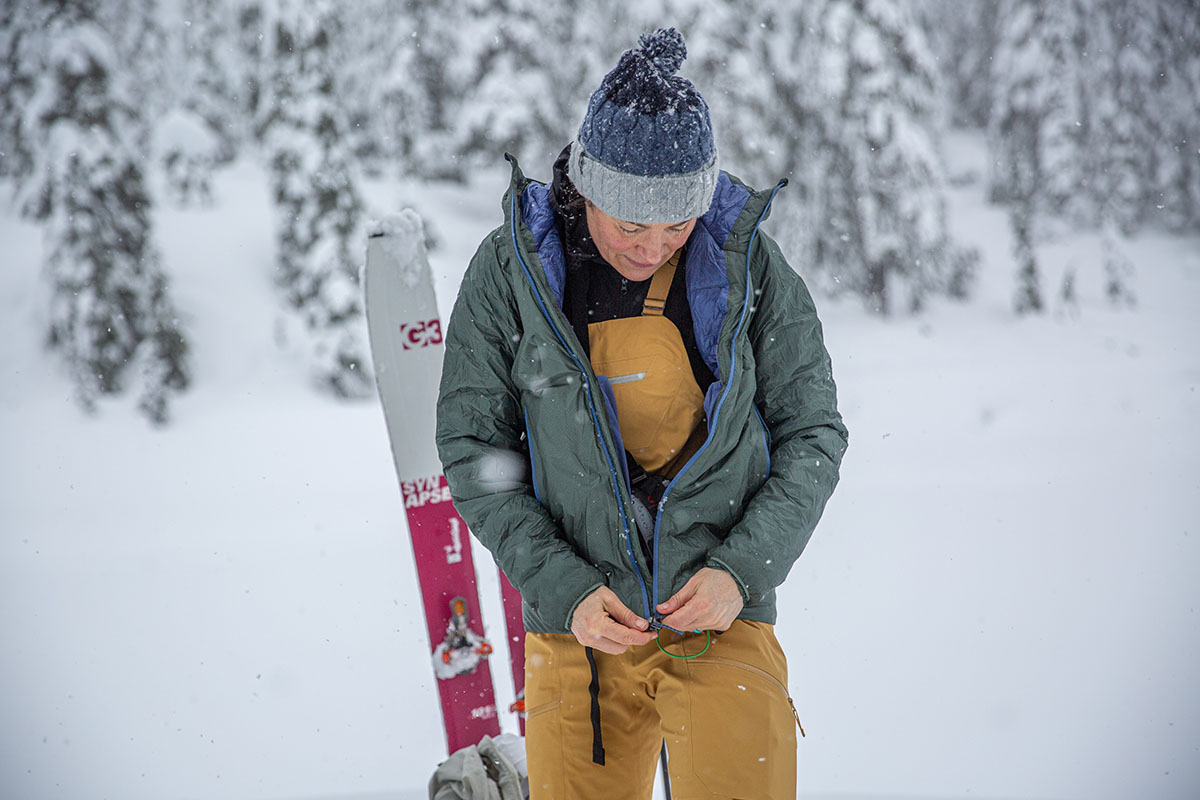
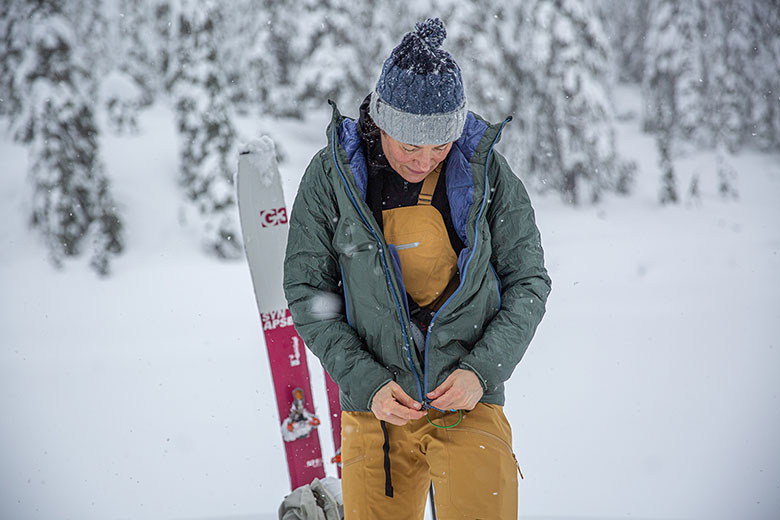
Price: $549
Weight: 1 lb. 0.9 oz. (women’s small)
Insulation: PlumaFill (90g)
What we like: Down-like warmth and compressibility and reliable wet-weather protection at a very competitive weight.
What we don’t: Expensive, hood is prohibitively snug over a ski helmet, and no two-way main zipper.
See the Women's Micro Puff Storm Jacket See the Men's Micro Puff Storm Jacket
Patagonia’s Micro Puff is legendary in the synthetic jacket world for its down-like warmth and compressibility, and the Micro Puff Storm turns up the performance dial with a waterproof shell and thicker insulation for cold-weather adventures. We put the women’s version to the test while backpacking in southern Patagonia and ski touring on Vancouver Island and came away impressed by its combination of stalwart protection and cozy warmth at a very reasonable weight. It’s quite pricey at $549 and could use a couple of small improvements—including a larger hood and a two-way main zipper—but overall, it’s an excellent companion for frigid backcountry and alpine adventures in inclement weather. Below we break down our experiences with the Micro Puff Storm Jacket. To see how it stacks up to the competition, see our articles on the best synthetic insulated jackets and best winter jackets.
Patagonia’s PlumaFill insulation does a laudable impression of down’s lofty warmth, and the Micro Puff Storm Jacket uses a thick 90-gram (g) variety that’s well suited for frigid winter adventures. My first outing with the jacket was a full day of fly fishing along Vancouver Island’s Cowichan River in December. Layered over my Arc’teryx Proton Hybrid Hoody, the Micro Puff Storm kept me warm and cozy despite being mostly sedentary. Since then, the jacket has become a staple in my backcountry ski kit—it’s the first layer I throw on during transitions and photo ops—and was a welcome addition on an unseasonably cold, wet, and blustery backpacking trip in Patagonia. Importantly, the synthetic insulation also maintains its warmth when wet, unlike down fill, which clumps up and loses its insulating abilities. This isn’t a huge concern given the Micro Puff Storm’s waterproof build (more on this below) but provides a nice dose of added assurance should the interior get damp from sweat or wet gear stored in the dump pockets. 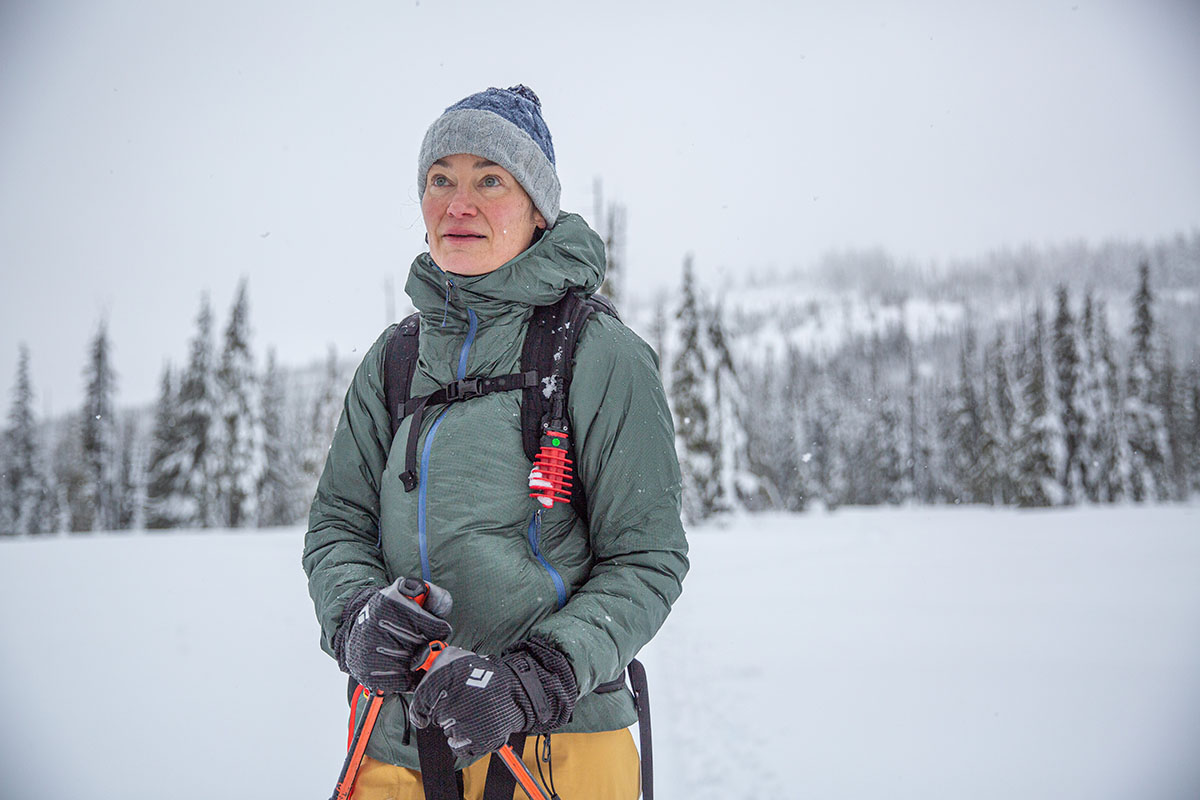
Many insulated jackets boast water-resistant shells for fending off light moisture, but the aptly named Micro Puff Storm takes it a step further with a 2-layer H2No build that’s fully waterproof. Along with a durable water repellent (DWR) finish and weather-resistant Pertex Quantum lining, the jacket has proven to be a highly reliable companion in harsh winter conditions. For reference, I’ve subjected it to everything from sleet and hail to snow and torrential rain and have remained perfectly dry throughout. In fact, I’ve come to trust it enough that I often don’t pack an additional hardshell jacket on frigid days. In milder weather, I often swap the Micro Puff storm for a puffy/shell combo so that I can customize warmth and protection depending on conditions and my own body temperature. But again, the Micro Puff Storm’s two-in-one appeal is hard to beat on cold, wet, and blustery missions into the backcountry or alpine.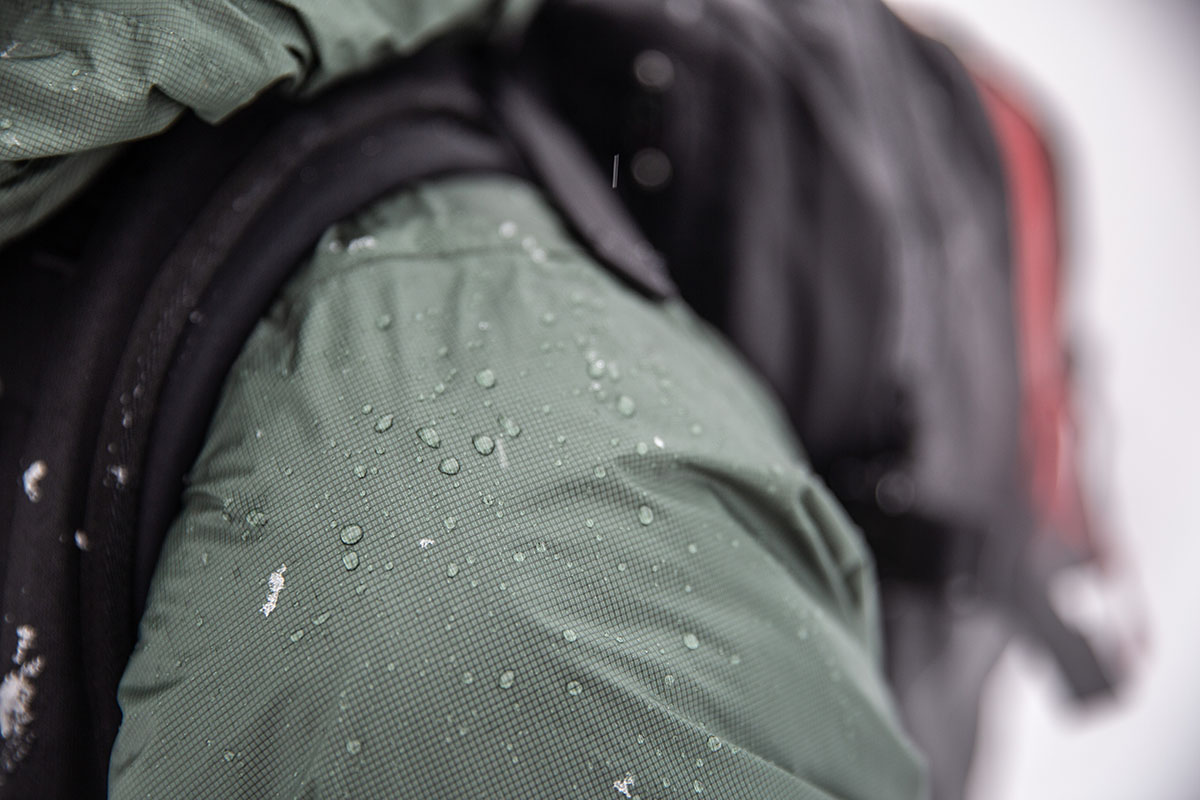
In addition to its waterproof construction, the Micro Puff Storm Jacket boasts a nice assortment of protective features to help seal out the elements. First, the hood is easy to adjust via a single drawcord at the back and features an elasticized binding around the aperture to trap warmth. It’s a similar story at the hem, which can be tightened via dual toggles and boasts a gasket along the inside to keep wind out (and body heat in). I also appreciate that the hand pockets are positioned high enough to sit above a hipbelt or climbing harness for tucking my hands into while belaying or hiking, and the mesh lining allows me to take advantage of my body heat to expedite the thawing process. Finally, the elasticized cuffs sit tightly against bare hands or thin liner gloves and can be tucked into gauntlet-style mittens when you need the added protection and warmth. The only notable omission is a two-way main zipper, which would be very handy for cold belays (I’m not sure why Patagonia dropped this from the past version).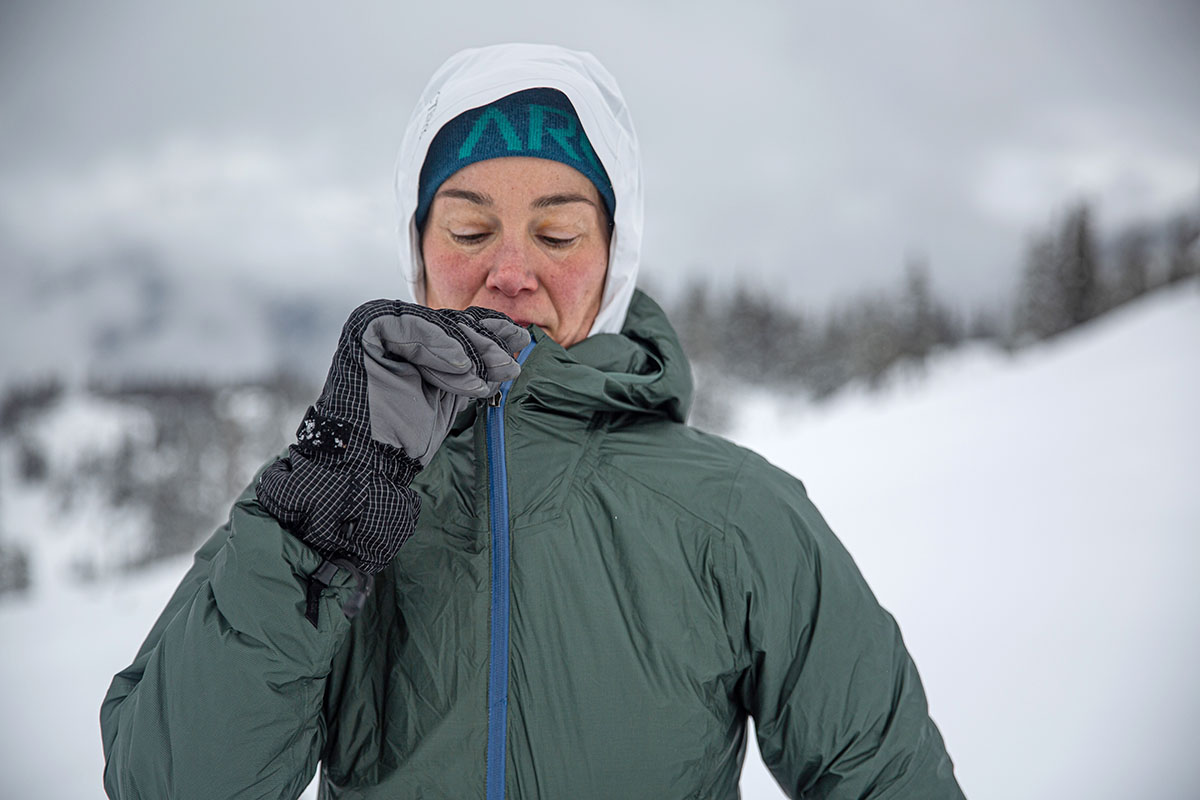
Breathability is unsurprisingly not the Micro Puff Storm’s strong suit. To be fair, I haven’t overheated in the jacket during light exertion, but I’m quick to take it off as soon as the sun comes out or I start to build up heat on the skin track. That said, even when I start to sweat, the interior doesn’t grow clammy against the skin, and the PlumaFill insulation continues to insulate—a known advantage that synthetic fill has over down. Patagonia didn’t include pit zips for dumping excess heat quickly, but the mesh backing inside the hand pockets allows for decent airflow with the zippers open (provided the pockets are empty). In the end, the Micro Puff Storm wouldn’t be my first choice for working hard in mild conditions, but it’s great for frigid tours, cold-weather backpacking, and other heart-pumping winter activities—especially when inclement weather is in the forecast.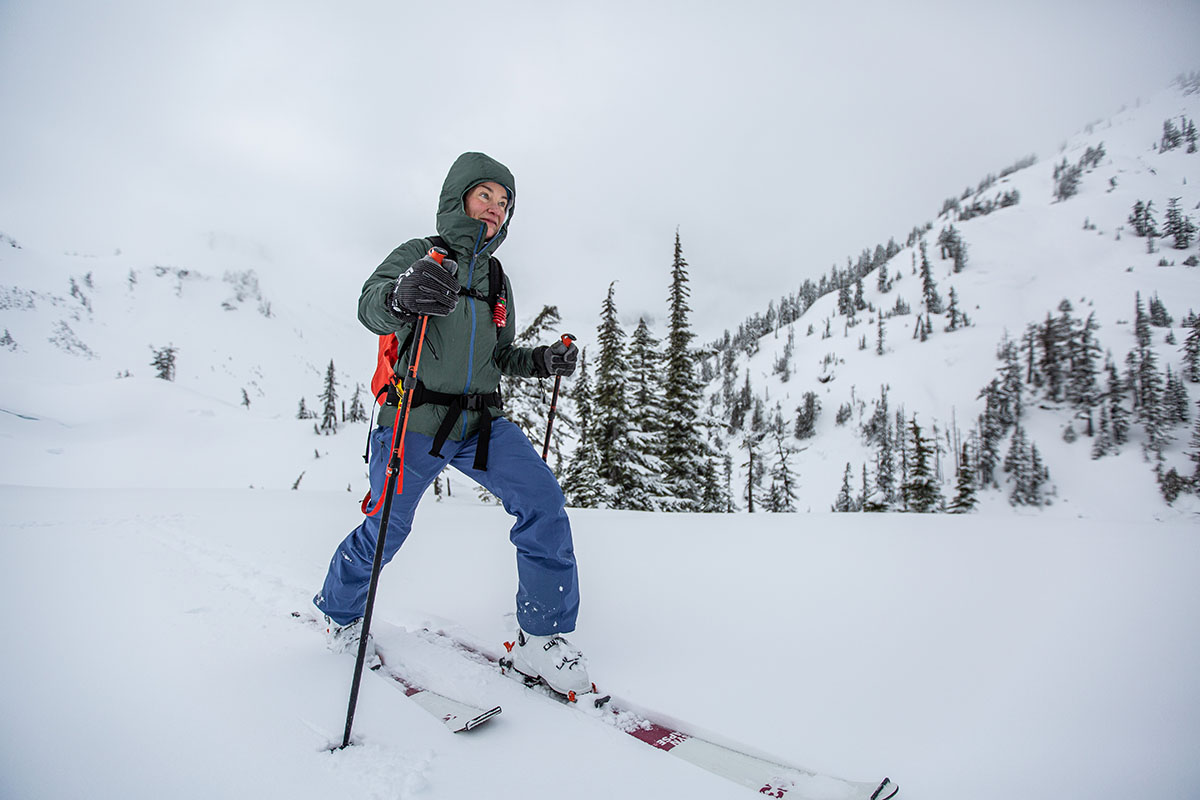
At 1 pound 0.9 ounces for my women’s small (listed weight is 1 lb. 1.1 oz.), the Micro Puff Storm Jacket is impressively light given its levels of warmth and protection. For comparison, Arc’teryx’s similarly intentioned Beta Insulated Jacket is heavier at 1 pound 5.2 ounces, while Patagonia’s own Das Parka—which is a little warmer but less protective than the Micro Puff Storm—checks in at 1 pound 2.4 ounces. Importantly, the Micro Puff Storm also stacks up very well to leading heavyweight down jackets, including the Rab Neutrino Pro (1 lb. 1.7 oz.) and Black Diamond Vision Down Parka (1 lb. 1 oz.). Neither of those jackets is waterproof like the Patagonia, but the takeaway is that the Micro Puff Storm is exceptionally light for a comparably warm synthetic piece.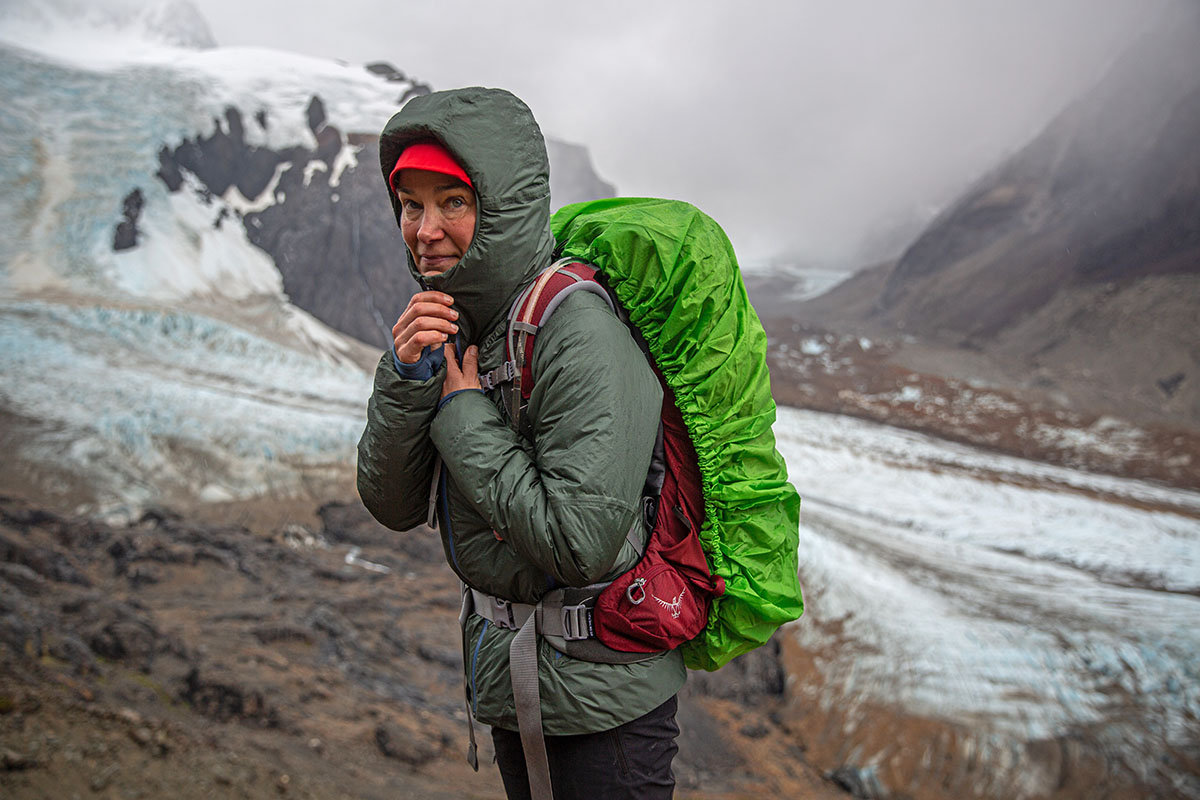
In terms of packability, the Micro Puff Storm is designed to stuff down into the left hand pocket. It’s a bit of a tight fit and puts some strain on the seams, so I typically opt to just roll the jacket into its hood for storage. Regardless of which method you choose, the Micro Puff Storm packs down to about the size of a loaf of bread. In a dedicated compression sack, it can be reduced to the size of a cantaloupe, which is quite impressive given the jacket’s well-insulated and weather-ready build.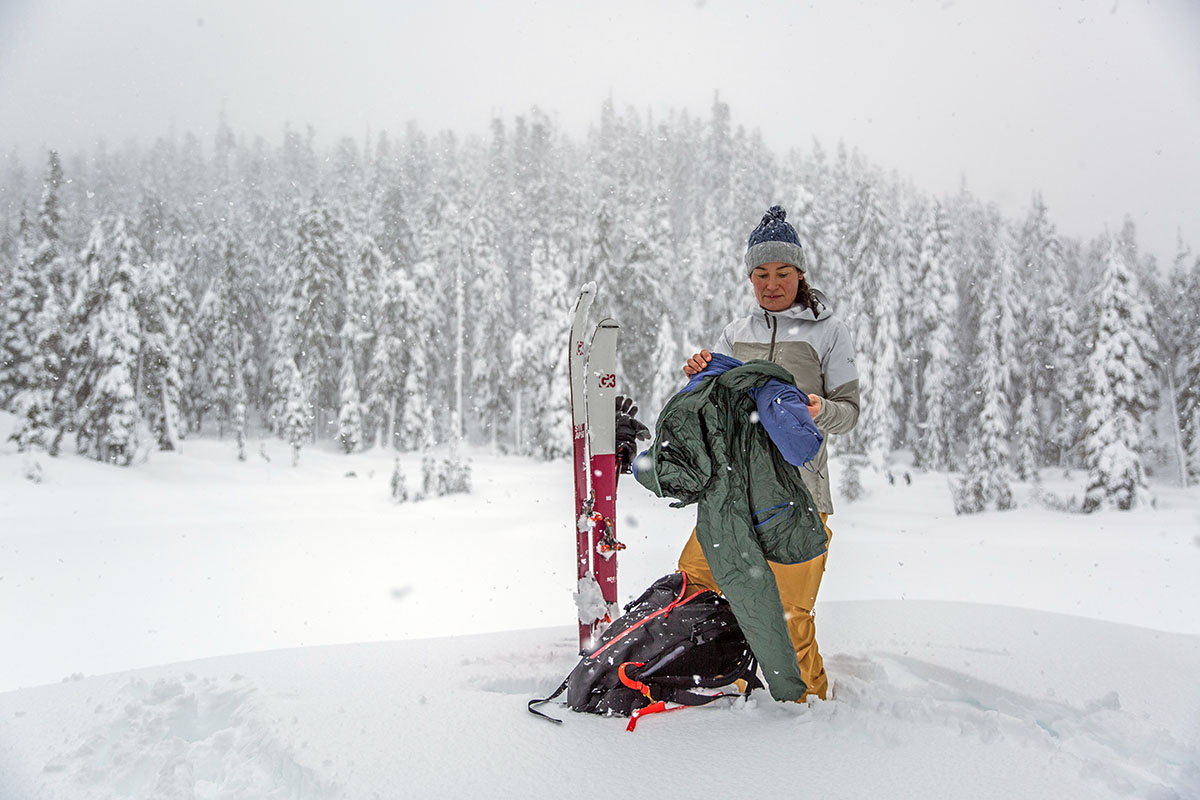
The standard Micro Puff has never been a standout in durability, but the Micro Puff Storm feels much more trustworthy and hardwearing. Patagonia wasn’t able to provide a denier spec, but the shell feels noticeably thicker and more confidence-inspiring than the Micro Puff’s thin 10-denier (D) construction. As I mentioned, my first outing with the jacket was a full day of fly fishing that required a lot of bushwhacking. While I was initially concerned that the Micro Puff Storm’s shell would suffer some damage, it emerged entirely unscathed. Since then, the jacket has been shoved haphazardly in ski and backpacking packs, scraped against boulders, and generally abused with no signs of wear to date. All the smaller components are holding up equally well, from the hood and hem toggles to the smooth-operating zippers and clean seams. I’d still recommend exercising caution around sharp equipment, but all signs are positive that the Micro Puff Storm will have a long and healthy lifespan.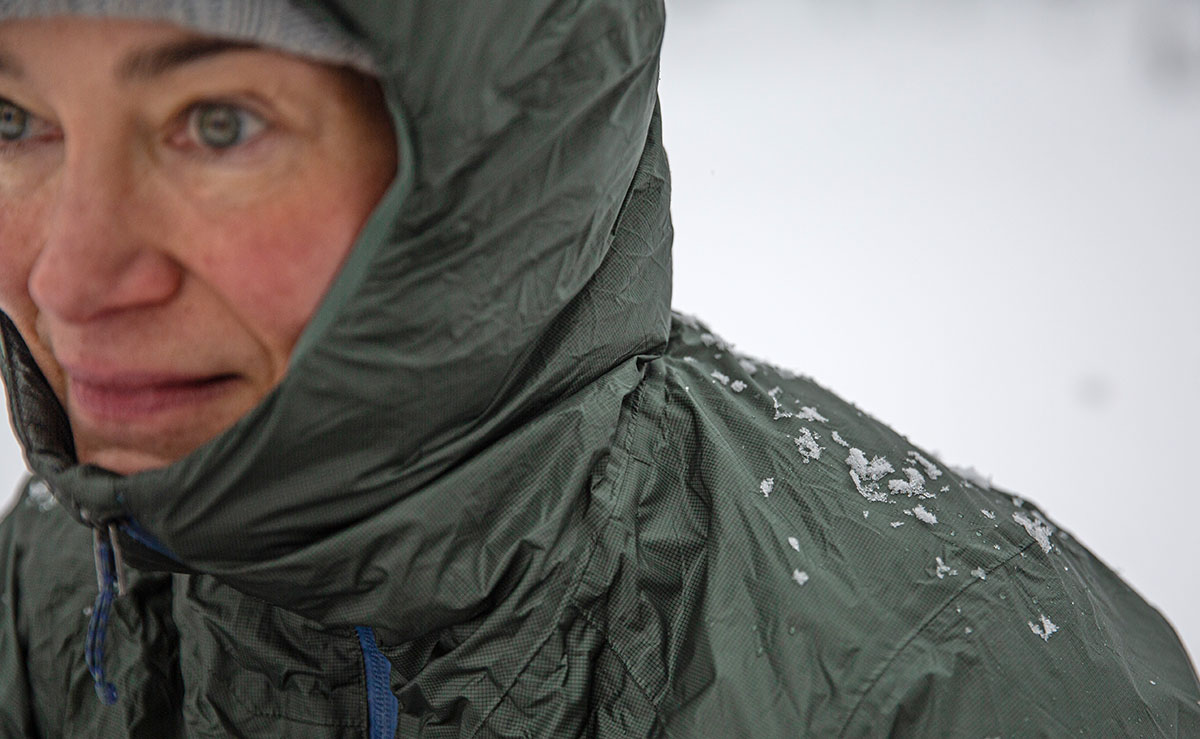
The Micro Puff Storm’s hood is well executed for sealing in warmth. As I touched on above, the design features an elastic binding around the edges that sits flush against the forehead and does an admirable job of trapping heat and keeping wind at bay (it functions like a baffle in a sleeping bag). The hood itself is large and easy to adjust via a glove-friendly toggle at the back, although it was noticeably snug over my Smith Valence ski helmet. With the jacket fully zipped, I couldn’t move my head side to side without considerable tugging. It worked much better with just a beanie underneath, but the lack of ski helmet compatibility is a notable drawback for backcountry and alpine use. Finally, Patagonia cleverly stowed a Recco reflector in the hood, which adds a nice dose of assurance in the event of a backcountry emergency.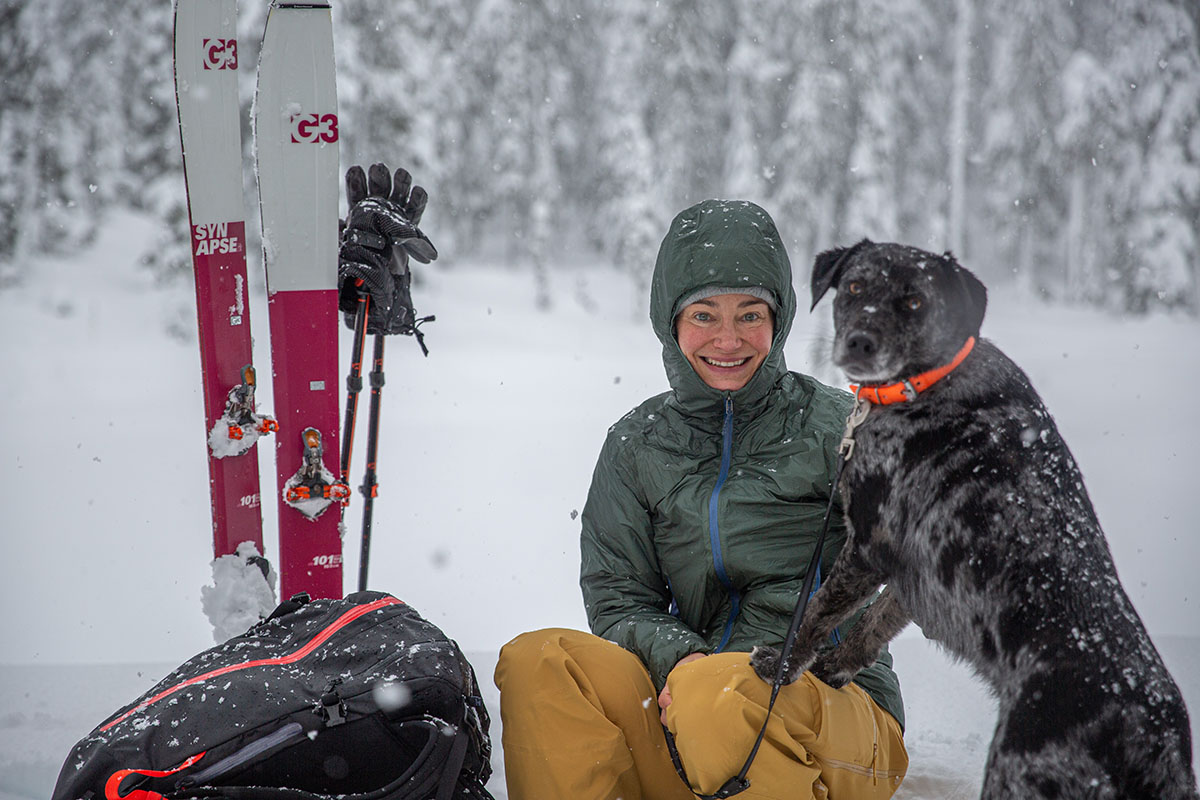
In terms of storage, the Micro Puff Storm comes well equipped for stashing the essentials with four total pockets. On the outside, you get two zippered handwarmer pockets that are generously sized and sit high enough on the torso to clear a harness or hipbelt. They’re also lined with mesh, which allows me to take advantage of my body heat to warm cold hands and can also provide ventilation if needed. Moving to the inside of the jacket, there are two stretchy dump pockets that easily swallow items like ski goggles, spare gloves, a map, or a beanie. I prefer not to stash wet climbing skins here to avoid moisture making its way to my base/midlayers, but the dump pockets are big enough to make it work in a pinch.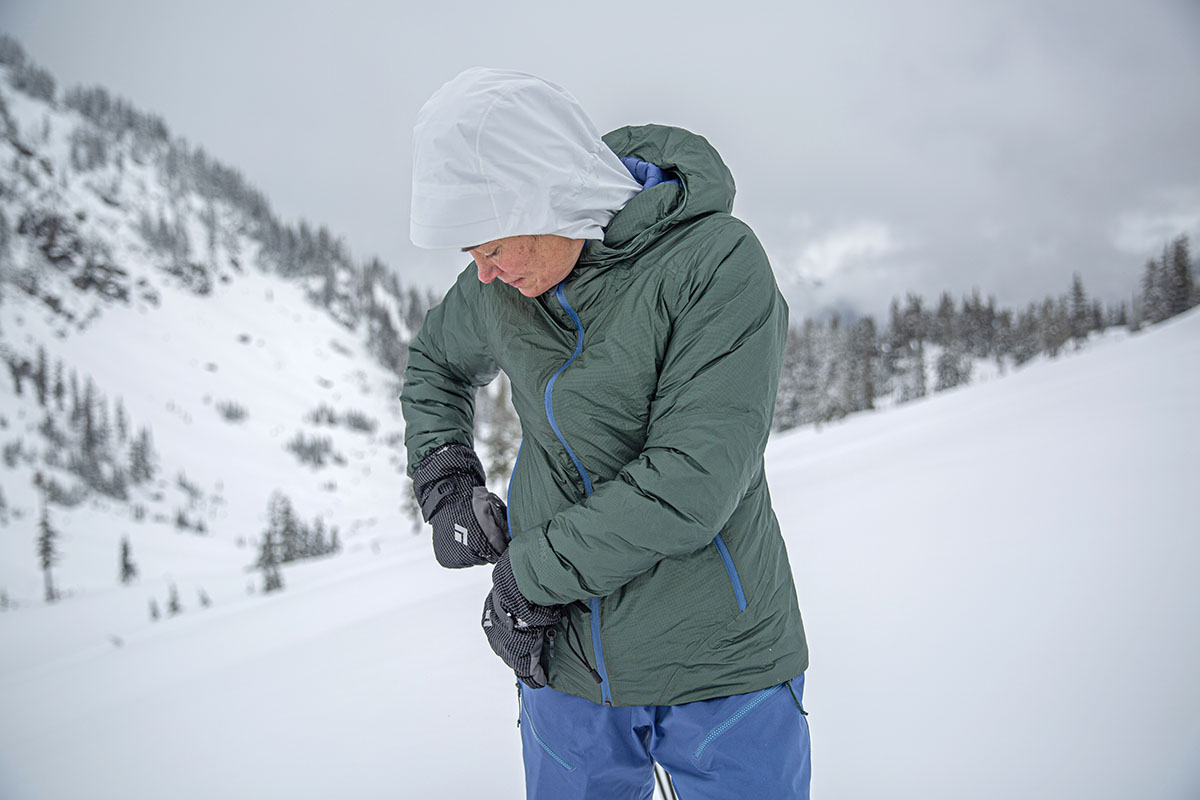
The Micro Puff Storm boasts Patagonia’s “regular” fit, which is designed to allow room for generous layering underneath without feeling overly bulky on its own. Overall, I’d say they pulled it off quite well: My standard women’s small was roomy enough that I could add a thick baselayer and midlayer underneath without any restriction to movement, and I also often added a hardshell underneath, too, for extra warmth while transitioning or sitting around camp. Those looking for a sleeker, more athletic fit might want to size down (at the cost of layering ability), but I feel that the Micro Puff Storm’s fit lines up well with its intentions.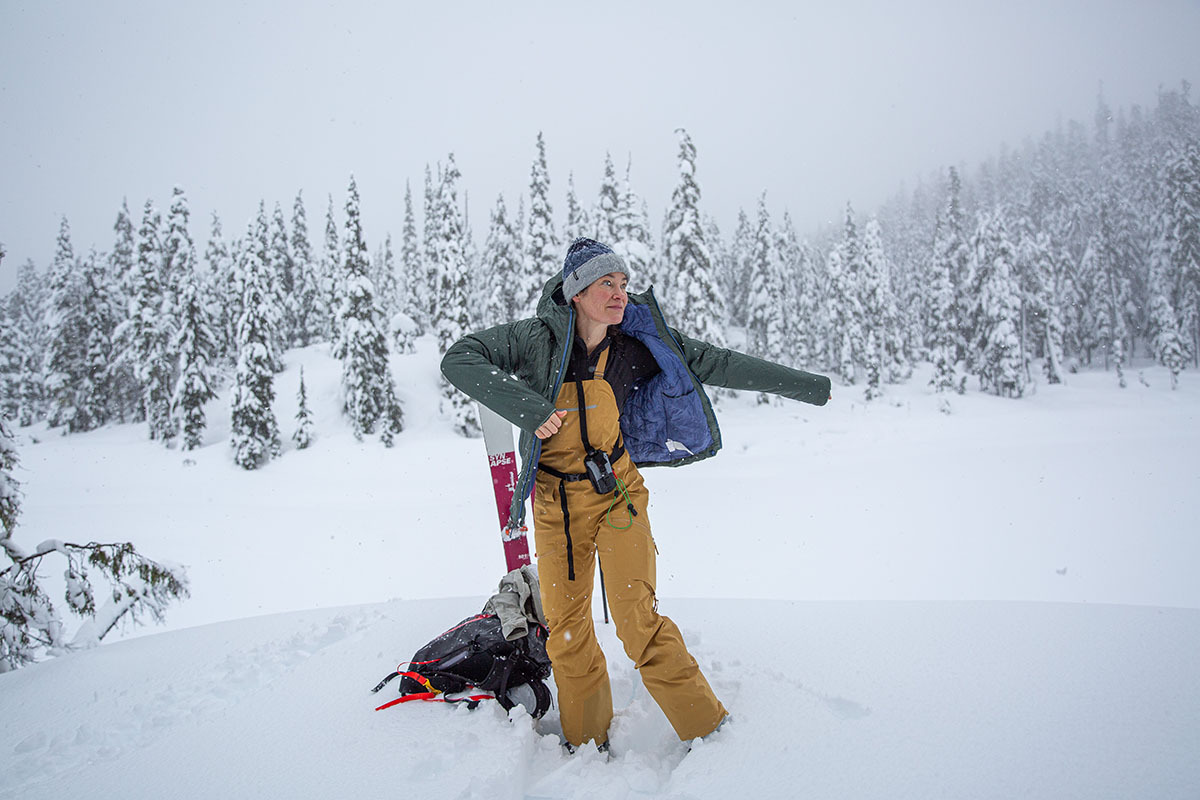
Patagonia is at the forefront of the sustainability push in the outdoor industry, and the Micro Puff Storm is a nice reflection of their prowess. First, the shell and lining are made from 100% recycled nylon and use PFC-free DWR coatings that forgo the use of harmful perfluorocarbons, which are known as “forever chemicals" due to their inability to break down over time. The PlumaFill insulation is also made from 100% recycled polyester, and the jacket boasts a Fair Trade Certification that indicates Patagonia put extra money into production to ensure workers are compensated fairly and have access to safe working conditions and benefits like healthcare and childcare services. Taken together, it’s a very intentionally built design and another feather in Patagonia’s cap on the sustainability front.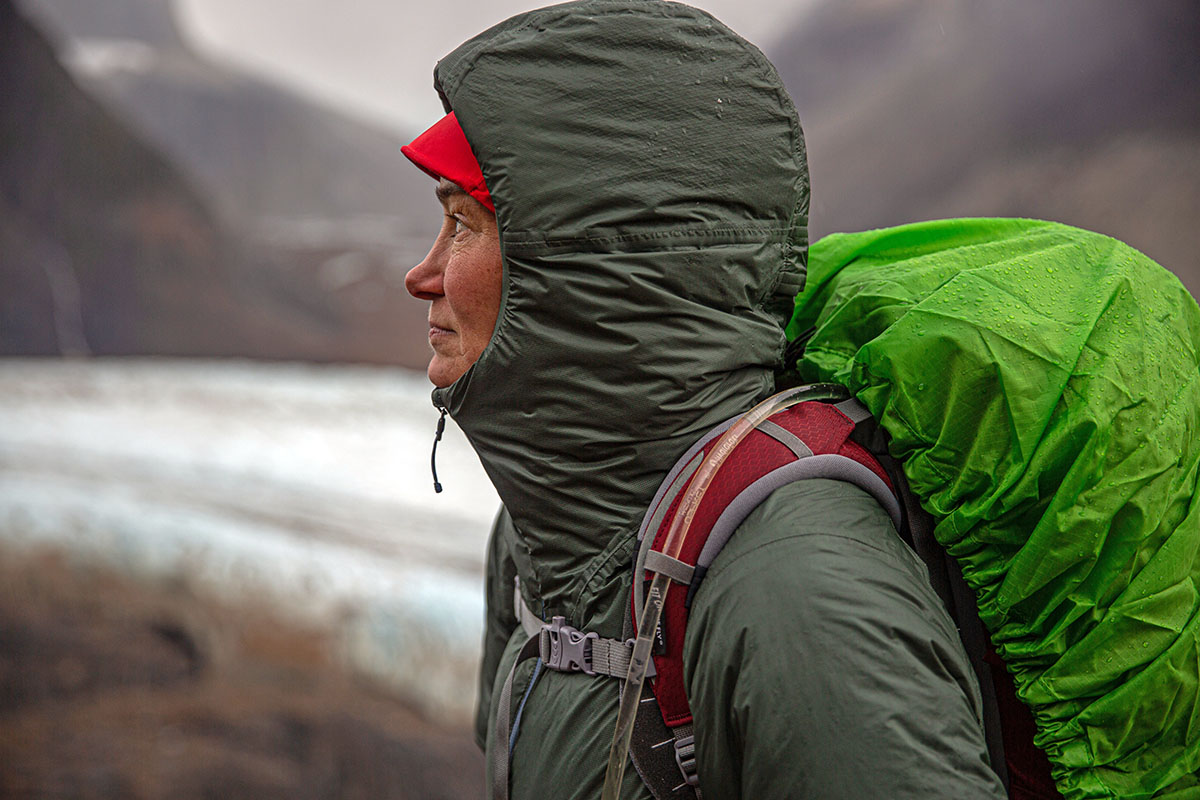
I covered the women’s Micro Puff Storm for this review, and it’s also sold in a men’s version. Comparing the two, the men’s Micro Puff Storm Jacket costs the same as the women’s model at $549 and shares a nearly identical build and feature set but checks in a little heavier at 1 pound 3.8 ounces and is available in different colorways. We haven’t had a chance to test the men’s jacket yet but expect overall performance to be largely similar.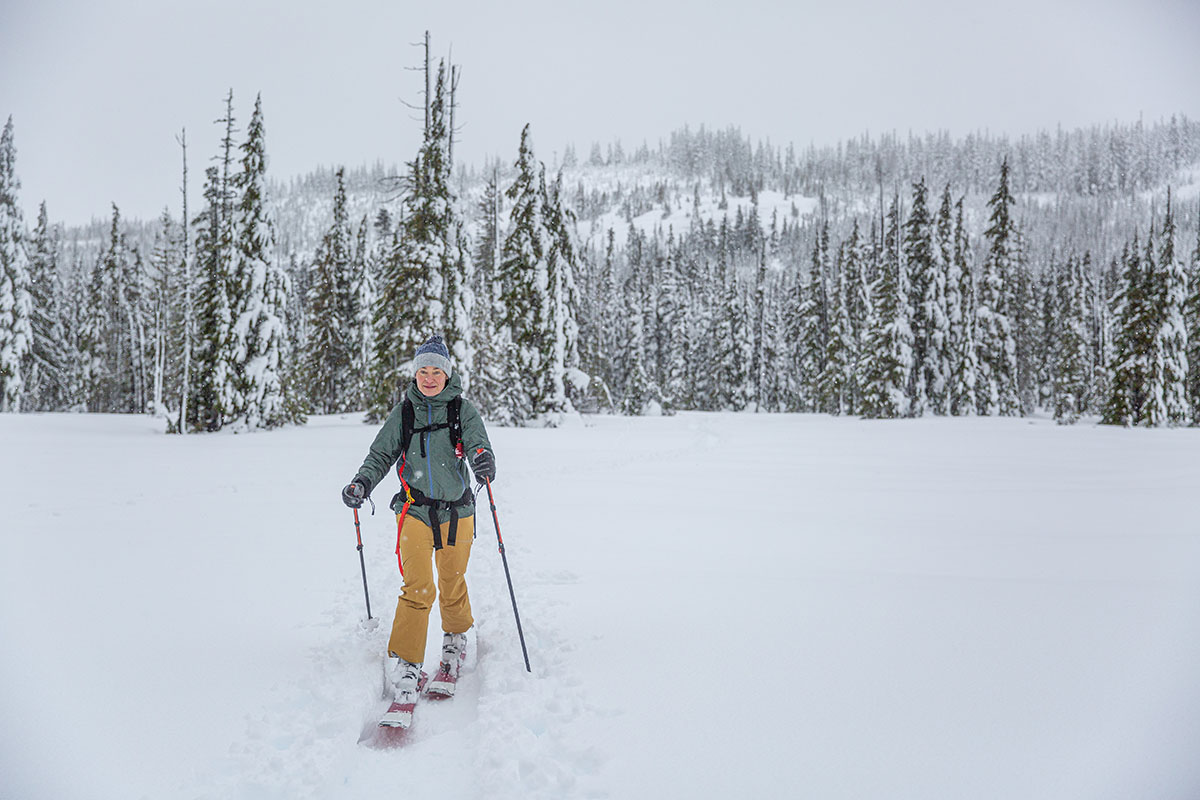
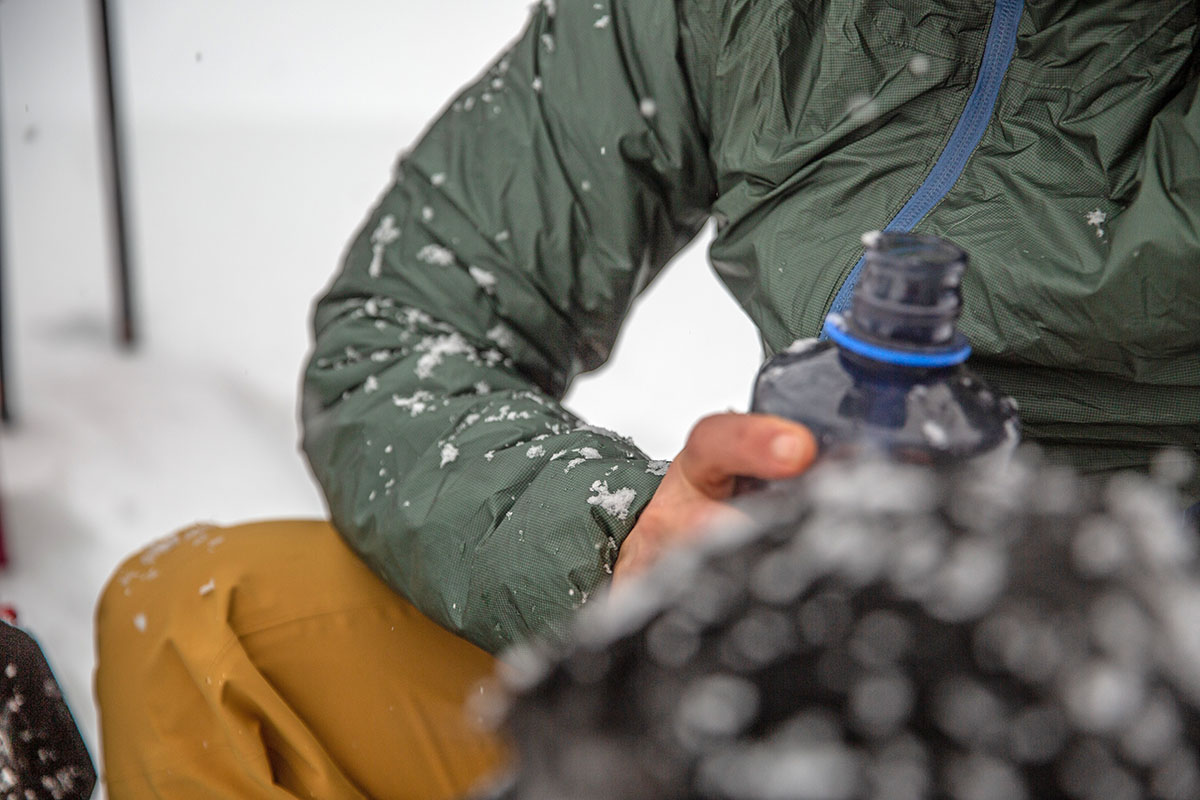
| Jacket | Price | Weight | Insulation | Fabric | Packable |
|---|---|---|---|---|---|
| Patagonia Micro Puff Storm | $549 | 1 lb. 1.1 oz. | PlumaFill (90g) | Unavail. | Hand pocket |
| Patagonia Das Parka | $449 | 1 lb. 1.4 oz. | PrimaLoft Gold Eco (133g & 40g) | 10D | Stuff sack |
| Arc’teryx Beta Insulated Jacket | $750 | 1 lb. 5.2 oz. | Coreloft (90 & 100g) | 40D | No |
| Arc'teryx Atom Heavyweight | $350 | 13.9 oz. | Coreloft (60, 80, & 120g) | 30D | No |
| Rab Neutrino Pro Jacket | $385 | 1 lb. 1.7 oz. | 800-fill down (7.5 oz.) | 20D | Stuff sack |
The Micro Puff Storm is a standout in the synthetic jacket market for its waterproof shell and down-like warmth and compressibility. While not waterproof, Patagonia’s own Das Parka is another one of our favorite winter-ready synthetics. For $100 less, the Das Parka swaps in a Pertex Quantum Pro shell that can fend off wind and light moisture but won’t stand up to sustained precipitation. That said, it gets the edge in warmth with 133g PrimaLoft Gold Eco insulation throughout and an extra 40g at the core while checking in around the same weight. And the feature set lines up well for alpine use, including a climbing helmet-compatible hood with an elasticized binding, five pockets, a two-way zipper backed by a wind flap, and internal elastic cuffs that double as thumb loops. The Das is too warm to be worn during exertion, but it’s great for cold belays, breaks while skiing, and other low-output uses. For working hard in cold conditions, especially when it’s raining or snowing, the Micro Puff Storm is the better match.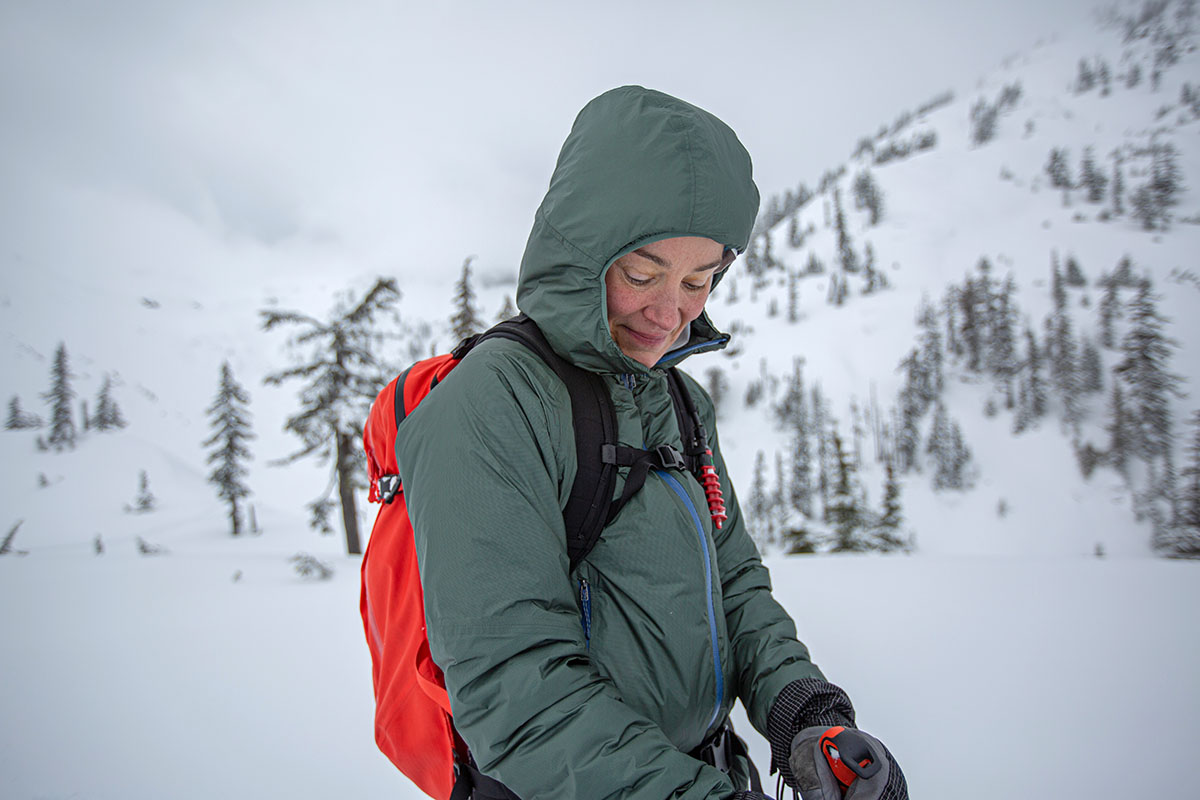
One of the Micro Puff Storm’s closest competitors is Arc’teryx’s Beta Insulated Jacket. While substantially pricier than the Patagonia at $750, the Beta Insulated stacks up very competitively: You get a 2-layer Gore-Tex membrane for stalwart protection from the elements, a mix of 90 and 100g Coreloft Continuous insulation for warmth, and a thoughtful assortment of backcountry-ready features. These include a helmet-compatible StormHood, pit zips, a two-way front zipper, a Recco reflector, and five total pockets (three exterior and two interior). It’s also pretty robust with a 40D shell, although we haven’t had any durability issues with the Micro Puff Storm to date. In other words, unless the added features are must-haves for you, the Patagonia offers similar all-around performance for 4.1 ounces and around $200 less.
Next up is another Arc’teryx option to consider: their Atom Heavyweight Hoody. Right away, we’ll note that the Atom Heavyweight lacks a weather-ready outer shell and works best as a midlayer in inclement weather (we’d only wear it as an outer layer in favorable conditions). However, overall warmth stacks up similarly with a mix of 60, 80, and 120-gram Coreloft synthetic that will continue to insulate should it get wet. The Arc’teryx also undercuts the Micro Puff Storm in weight at an impressive 13.9 ounces without sacrificing much in the way of features—you get a helmet-compatible StormHood with a small brim for deflecting moisture, three total pockets (two hand and one internal), and a more breathable fabric under the arms to boost breathability. It will also save you a considerable $199 over the Micro Puff Storm, although the Patagonia’s fully waterproof construction is much more reliable in inclement backcountry weather and eliminates the need to pack a separate hardshell.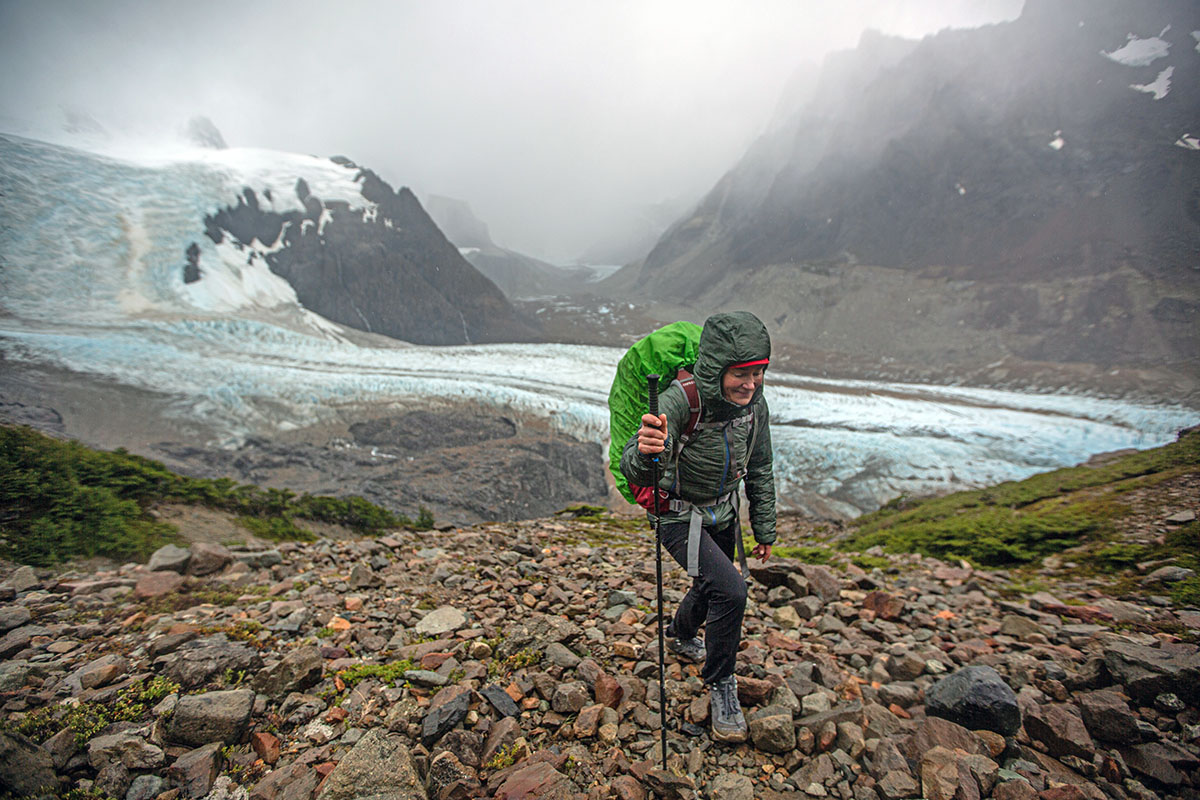
Finally, we’d be remiss not to compare the Micro Puff Storm to a true down jacket given its intentions, and our favorite heavyweight option is Rab’s Neutrino Pro Jacket. As we touched on above, down is more compressible and warmer for the weight than synthetic, but it tends to clump up when exposed to moisture and lose its insulating abilities. To combat this, Rab outfitted the Neutrino Pro with a weather-resistant Pertex Quantum Pro shell and coated the down fill with a hydrophobic treatment to help protect it from wetting out. You also get a nice assortment of backcountry-ready features, including a helmet-compatible hood with a stiff brim, a two-way main zipper, adjustable cuffs, and a stuff sack for packing the jacket down—all for around the same weight as the Micro Puff Storm. The Patagonia still gets the clear edge in protection, but for those who already own a hardshell, the Neutrino Pro offers winter-ready warmth at a hard-to-beat $385.
Editor’s note: We usually provide a live price comparison table below our outdoor gear reviews, but the Micro Puff Storm Jacket is currently only available directly through Patagonia. You can see the Micro Puff Storm page here and support us in the process. Thanks!